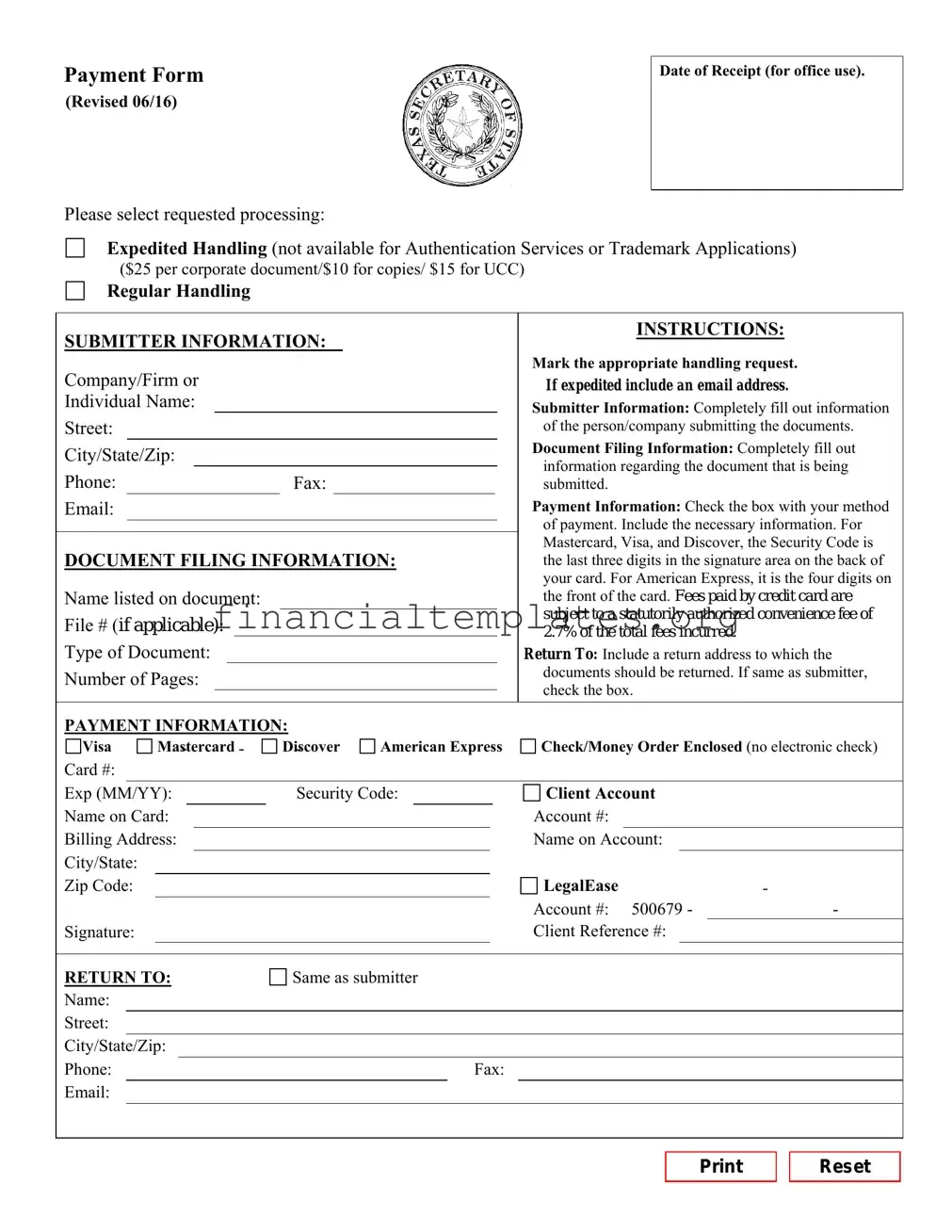The Texas SOS Payment 807 form, utilized for processing various types of official submissions to the Texas Secretary of State, shares similarities with a number of other forms in both structure and purpose. One of these similar forms is the IRS Form 1040, the U.S. Individual Income Tax Return form. Both forms require detailed personal and financial information to be filled out and submitted for processing. They also include sections for payment information and share the feature of allowing for expedited processing at an additional fee, illustrating their focus on accommodating different processing needs.
Another form that mirrors the Texas SOS Payment 807 in certain aspects is the Uniform Commercial Code (UCC) Financing Statement, commonly referred to as Form UCC1. This form, like the Payment 807, includes detailed submitter information, document filing details, and directives for handling and return instructions. Both forms are integral to the submission of official documents within the United States, serving key roles in business and legal proceedings by facilitating the recording of financial statements or business entity transactions.
Similarly, the Application for Employer Identification Number (EIN), known as Form SS-4, bears resemblances to the Texas SOS Payment 807 form. Both require the identification of the entity involved and necessitate detailed information regarding the submitter. Additionally, they include specific instructions for expedited processing and involve the inclusion of payment information, underlining the procedural similarities between applying for an EIN and submitting documents to the Texas Secretary of State.
The Articles of Incorporation form, utilized for establishing a corporation within various states, echoes the Texas SOS Payment 807 in structure. It includes requirements for detailed submitter and entity information, alongside specific document filing information. Both forms are crucial for the legal establishment and recognition of entities, emphasizing the need for precise and comprehensive information submission.
The Change of Registered Agent/Office form, another significant document in business operations, parallels the Texas SOS Payment 807. This form facilitates the official change of an entity’s registered agent or office location, necessitating detailed submission information similar to the Payment 807 form. Both require accurate submitter information and document details to ensure proper processing and recording of the submitted changes.
Additionally, the DBA (Doing Business As) registration form, used by businesses to register a trade name, shares commonalities with the Payment 807 form in terms of required submitter information and document filing specifics. The necessity for explicit instructions on processing and return information further aligns these forms in their purpose and structure, facilitating various business-related submissions.
The Trademark Application form, necessary for the registration of a trademark, aligns with the Texas SOS Payment 807 form in requiring detailed information on the submitter and the specifics of the submission. Although the Payment 807 specifies that it does not handle trademark applications with expedited service, both forms are integral to protecting business interests and intellectual property, underscoring their role in legal documentation processes.
Lastly, the Patent Application form parallels the Texas SOS Payment 807 in that it requires comprehensive details about the submitter, the invention, and the specifics of the patent being sought. Both forms are key to securing legal rights—whether for a business entity through the SOS Payment 807 or an inventor through the patent application process—demonstrating their critical role in safeguarding interests within their respective domains.

